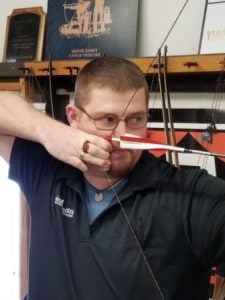
Whether you’re aiming for the gold or placing an arrow in the vitals of a whitetail, you need to learn the basic shooting methods for traditional archery. After learning the basics, you then need to decide on a style that best fits you. There are many different styles for shooting traditional bows and it can often be an overwhelming obstacle for the newcomer. Which one is the right one, or better yet, which one is the right one for you? In this segment, we’re going to discuss the different shooting methods. We’ll look at the advantages and disadvantages of each style to help you decide the best system for you.
Tab or glove:
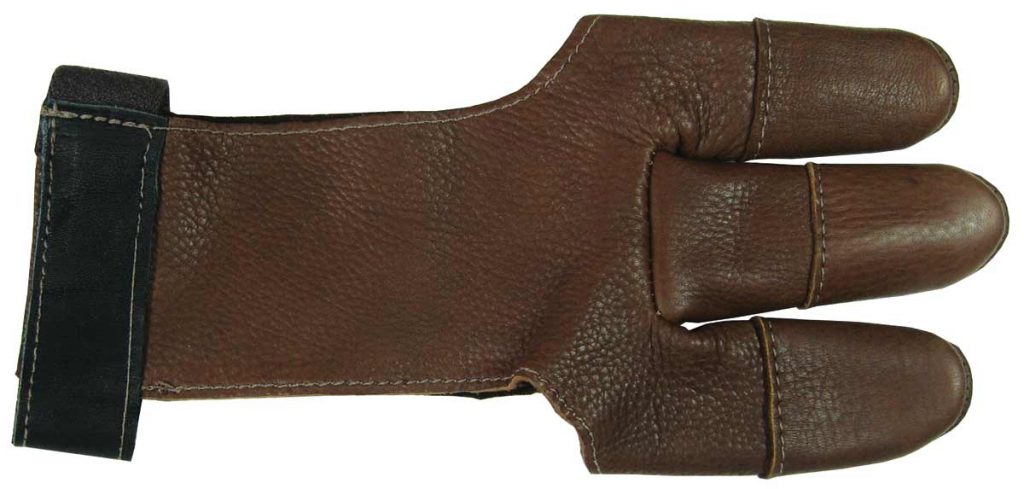
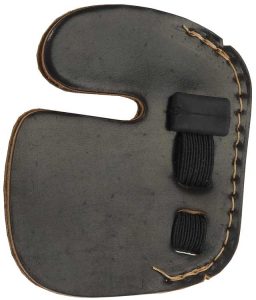
The first question is usually deciding whether a glove or a tab is the best choice. For the most part, it’s a personal preference. One of the benefits to using a tab is that it keeps all three fingers together on one surface. This allows the string to clear the tab with minimal effect preventing errant shots.
A glove has more of a natural feel to it, almost like a part of the hand. During cold weather, it can be more beneficial to the bowhunter. A simple trick is to cut the ends off the fingers from a regular glove and place your shooting glove over the top for added warmth.
Shooting methods for traditional archery
Three Under vs Split Finger:
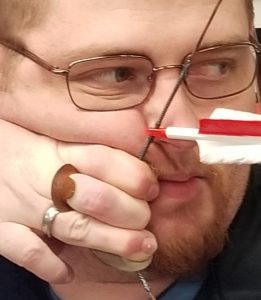
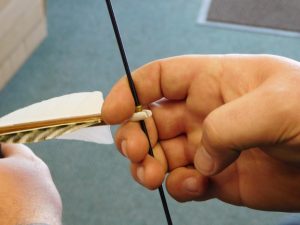
Three under is the practice of placing three fingers under the nock of the arrow. Split finger is placing the index finger above the nock, while the middle and ring fingers are below the nock. There are pros and cons to shooting three fingers under or split finger. However a good release can be accomplished with either manner.
Split finger is a preferred technique when long range shooting is involved, such as Olympic Shooting. Using this method places the back of the arrow lower than the point. This gives a more natural sight picture for the arc of the arrow. It takes a bit more practice when first learning as most beginners tend to pinch the nock when using split finger. A deeper hook and spreading the fingers apart will usually help resolve this problem.
Three under works well with traditional gear as the shot distances are often closer. It can be a good choice for string walking and fixed crawl shooting methods as it gets the arrow closer to the line of sight with close range targets. Most beginner archers will find this style a bit easier to learn.
Instinctive Shooting:
Many of the purists in traditional archery feel the only true form of shooting is instinctive shooting. Instinctive shooting is the most natural of all shooting techniques. In essence, you simply look where you want to shoot and shoot where you are looking. Unfortunately, it can be the hardest of the shooting methods to learn, yet the most rewarding to the bowhunter.
The best way for me to describe it is to imagine throwing a baseball. Most likely the first time you picked up a baseball and tried to throw it you were inaccurate because you hadn’t learned the basic techniques. Yet in a few years, it becomes second nature after learning the mechanics.
Instinctive shooting is similar, it takes a lot of practice, but once learned, it becomes a deadly method. Shooting your bow over and over, learning the arc of the arrow at varied distances will become second nature. After a while, you can visualize the shot in your mind. Just like playing shortstop in a baseball game. The player catches the ball and throws to first base, never thinking about how hard they are throwing, the arc of the ball, or the distance. It just becomes a learned process where the mind can subconsciously determine the arc of the arrow, the distance, and how to hold in relation to the target.
Once learned the bowhunter can take advantage by never thinking about the distance of the shot and instead focusing on where he wants to place the arrow. The disadvantage is that it is nearly impossible to become as accurate as some of the other methods. Become the Arrow book by Byron Ferguson is a great source of information on the subject of Instinctive Shooting.
Gap Shooting:
One of the most efficient shooting methods (without installing a sight) is called Gap Shooting. This style uses the point of the arrow, as if it was a sight, and adjusting for different ranges. Most gap shooters start by learning the “point on distance.” The point on refers to finding the distance where the arrow point is on the intended target and after releasing, the arrow hits the target at the intended spot.
From there, the archer moves to different distances to learn how much lower (or how much higher) to place the point of the arrow on the target and still hit it. Gap shooters can be extremely accurate, but it doesn’t lend itself to bowhunting. It’s an unnatural feel to hold so much lower than the target, which is a live animal in a hunting situation. It takes a longer thought process when the moment of truth is suddenly in front of you.
For those that want to learn instinctive shooting, this method can often be the first step in learning the process. It’s a very effective system at known distances, but more suited for the target than the woods.
String Walking:


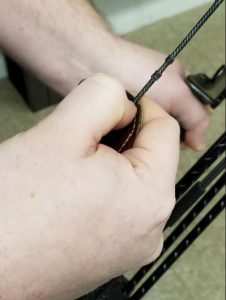
As in gap shooting, this method involves using the arrow point as a sight. The primary difference is that you will always place the point on your target no matter the distance. In order to achieve this, you place your fingers at different locations on the string, which changes the angle of the arrow. Where gap shooting is raising and lowering your front sight (arrow point), string walking is raising and lowering the rear sight to effect the imapact.
Once your point on distance is learned, you begin practicing at different distances. By moving your fingers up or down the string, you figure out the position for the arrow to still be point on. The string is then marked for each particular distance and the tab is placed there when drawing the bow. Some archers count the serving wraps, others will mark their tab for different yardages making it quick and accurate to find the right location on the string. The Bateman Cordovan Tabs are great for this style of shooting. At one point, target archers were able to become so accurate using this style that rules had to change and new classes evolved from it.
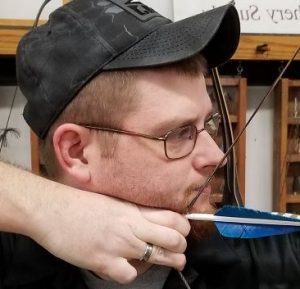
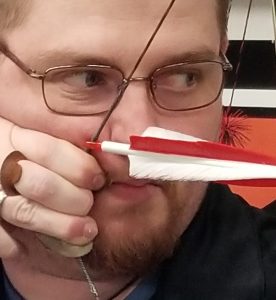
A variation of sting walking is called “Face Walking”. The concept is much the same, but the major difference is instead of placing your fingers on different areas of the string, you simply change your anchor point. It requires learning new anchor points that will raise or lower the arrow. For example, you may place your ring finger in the corner of your mouth for one shot and your index finger at the same location for a different shot. For extremely long shots, you may find anchoring beneath your chin to be effective.
The downside is that you still need to accurately judge distance and correspond it to the markings on the string or which anchor point to use.
Fixed Crawl:
The fixed crawl method is quickly gaining popularity and incorporates different parts from the Gap shooting and String Walking shooting methods listed above. It involves placing another nocking point below the nocking point of the arrow. You will want to get back from the target at approximately twenty five yards and find where you need to locate your hand on the string so that the arrow is point on at that distance.
Once you have achieved this, you place a nocking point at that location and practice with the point on with ranges less than twenty five yards. The idea is that most bowhunters rarely shoot beyond this distance, so effectively the arrow because a sight that needs little (if any) adjustment at ranges up to twenty five yards. Basically, you are just looking down the shaft and placing the point where you want to hit.
This shooting method is quickly becoming popular with traditional bowhunters. It gives a fast and easy reference without having to think much about the shot. But probably not a method for a true target shooter since the range is limited. It’s a great method for IBO with shorter distance like 35 yards and less. String walking is preferred for the 70 meter courses.
Fixed Sights:
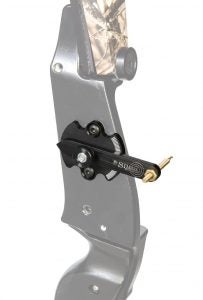
While not as popular in the world of traditional archery, fixed sights have been around for a long time. However, it is a probably the most accurate of all shooting methods and very common in target and field archery. Most bows can be setup with some sort of sighting mechanism, the most common being a pin sight. Usually there will be several pins set at different yardages and located above the arrow point.
The archer keeps his eye in line with the string while placing the pin on the target. This is a highly accurate process that is usually fairly easy to learn. There isn’t much downside to the target archer, but in low light conditions it can be problematic for the bowhunter.
The important thing to remember is that you need to find which of the shooting methods work best for you. What works for one person doesn’t necessarily work for another. Try the different methods and see what you like and don’t like about them. Eventually, you will most likely settle on one and then it becomes a matter of practice. The one thing they all have in common is that each method requires consistency with a solid anchor point. The Masters of the Barebow DVD series is an excellent resource for learning different methods from the top shooters in the country.
By R. Strong
[subscribe2]














.jpg)
